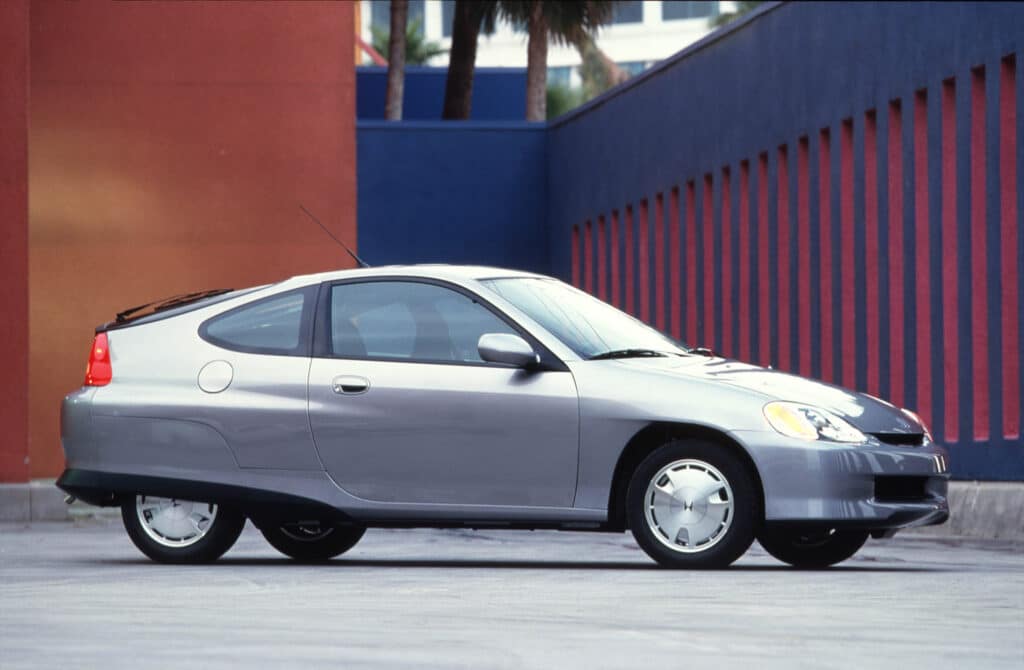Honda’s Hybrids Now Represent Over 25% of its Sales, Honda Insight Was First in US Market
If you ask most people to name the first hybrid car available in the US, they’ll probably say the Toyota Prius. However, the ground-breaking first-generation Honda Insight was the first.
In December, Honda marked a significant milestone—25 years of hybrid-electric vehicle sales in the United States. This journey began with the original Honda Insight, the very first mass-produced hybrid vehicle ever sold in America, which made its debut in December 1999. With a focus on innovative technologies, the Insight became the epitome of efficiency, holding the title of the most fuel-efficient hybrid ever in America, with an impressive EPA highway rating of 70 mpg.
Today, Honda’s commitment to hybrid-electric vehicles continues to thrive. Over 25% of Honda brand sales are now hybrid-electric models. Popular models like the Civic, Accord, and CR-V feature Honda’s award-winning two-motor hybrid-electric system, reinforcing the company’s ongoing role in the push toward a more sustainable, electrified future.

“Twenty-five years after making history with America’s first hybrid-electric vehicle, hybrids now account for more than 25% of Honda auto sales,” said Jessika Laudermilk, assistant vice president of Honda Auto Sales. “As we advance step-by-step toward our goal of carbon neutrality for all products and corporate activities, our popular hybrid models are a critical part of our longer-term electrification strategy that supports our ultimate goal of zero environmental impact by 2050.”
First-Generation Honda Insight
The first-generation Honda Insight, produced from 1999 to 2006, remains a groundbreaking achievement in automotive history, especially in terms of fuel efficiency. Built alongside the NSX and S2000 sports cars at Honda’s Takanezawa Plant in Japan, the Insight earned the distinction of being the most fuel-efficient gasoline-powered mass-production vehicle ever sold in the United States. It achieved 61 mpg city and 70 mpg highway according to the EPA, a record that still stands today.
Honda’s engineers applied a variety of innovative technologies to make the Insight a reality. Among the key features was the Integrated Motor Assist (IMA™) hybrid powertrain, which combined a small, efficient 1.0-liter gasoline engine with an electric motor to boost fuel economy without sacrificing performance. The engine was not only the world’s smallest and lightest in its category, but it was also designed with efficiency at the forefront.
Aerodynamics and lightweight construction played pivotal roles in achieving the Insight’s exceptional mileage. Honda’s expertise in aluminum, which had already been demonstrated in the NSX supercar as the world’s first mass-produced all-aluminum vehicle, was carried over into the Insight’s design. The two-seater’s aluminum body—featuring a combination of stamped sheets, extruded frames, and die-cast components—reduced weight by nearly 50% compared to a steel-bodied vehicle like the Civic Hatchback. Despite this significant weight reduction, the Insight’s body exhibited 38% more torsional rigidity, ensuring strength and safety without compromising fuel economy.
Another remarkable aspect of the first-generation Insight was its aerodynamic design, with one of the lowest drag coefficients (0.25) ever recorded for a mass-produced car. These combined efforts in lightweight construction and aerodynamic efficiency made the Insight a pioneering model in the automotive world, setting the stage for the future of hybrid-electric vehicles.
Honda’s Hybrid-Electric Models Made in America
Honda’s current hybrid-electric models are proudly manufactured in the U.S. and Canada, highlighting the company’s commitment to North American production. The Honda CR-V Hybrid is assembled in three plants: the East Liberty Auto Plant in Ohio, the Indiana Auto Plant, and the Alliston Auto Plant in Canada. The Honda Accord Hybrid is produced exclusively at the Marysville Auto Plant in Ohio. Meanwhile, the Civic Hatchback Hybrid is built at the Indiana Auto Plant, while the Civic Sedan Hybrid comes from the Alliston Auto Plant.
Honda’s North American plants also play a vital role in the production of key hybrid powertrain components. At the Honda Power Unit Operations in Ohio, associates are responsible for building the two-motor hybrid-electric power unit at the Ohio Transmission Plant and the 2.0-liter Atkinson-cycle four-cylinder engine at the Anna Engine Plant. These components are used in the Civic Hybrid, Accord Hybrid, and CR-V Hybrid, reinforcing Honda’s deep investment in hybrid technology and its ongoing role in producing advanced, fuel-efficient vehicles in North America.
Honda Hybrid-Electric Vehicles by Model Year
2000-2006 Insight
2003-2005 Civic hybrid
2005-2007 Accord hybrid
2006-2010 Civic hybrid
2010-2014 Insight
2011-2016 CR-Z
2012-2015 Civic hybrid
2014-2017 Accord hybrid
2018-2022 Accord hybrid
2017-2021 Clarity Plug-In Hybrid (PHEV)
2019-2022 Insight
2020-2022 CR-V hybrid
2023-current CR-V hybrid
2023-current Accord hybrid
2025-current Civic hybrid
Honda Electrification Strategy
Honda is committed to achieving carbon neutrality across all its products and corporate activities by 2050, with an ambitious goal to make battery-electric vehicles (BEVs) and fuel cell electric vehicles (FCEVs) account for 100% of its vehicle sales by 2040. Hybrid-electric vehicles (HEVs) play a pivotal role in this electrification strategy, serving as a key step toward fully electric transportation. In fact, hybrid-electric powertrains have been incorporated into Honda’s core models, marking an important phase in the company’s journey toward sustainability.
In 2023, the Honda CR-V Hybrid became America’s best-selling hybrid vehicle, and the Honda Accord Hybrid was the most popular hybrid car in the country. The new fourth-generation two-motor hybrid-electric powertrain now powers more than 50% of Accord and CR-V sales. Additionally, 2025 Civic Hybrid models are projected to represent around 40% of total Civic sales, further demonstrating Honda’s expanding hybrid portfolio. Honda has surpassed a milestone of one million cumulative sales of electrified vehicles.
The Honda Prologue, the brand’s first all-electric SUV is becoming very popular in the US. Selling 6,823 units in November 2024, and 25,132 from January through November, demonstrates the Prologue’s significant market traction in America. EVinfo.net recommends the Prologue.
Looking ahead, Honda will begin EV production of its original electric vehicles at the Honda EV Hub in Ohio in late 2025. This new manufacturing hub is designed to provide the flexibility to produce gasoline, hybrid-electric, and battery-electric vehicles on the same production line, streamlining the transition to electrification.
At CES 2024 in January, Honda unveiled two concept models in its Honda 0 Series—the Saloon and the Space-Hub—with plans for a production model of the Saloon to debut in fall 2026. This model will be positioned as the flagship of the Honda 0 Series and will be produced at the Honda EV Hub in Ohio. By 2030, Honda plans to introduce a total of seven Honda 0 Series models globally, encompassing small, medium, and large vehicles.
At the Honda 0 Tech Meeting 2024 in Tokyo, Honda introduced next-generation technologies to be applied in the Honda 0 Series. This entirely new EV lineup will launch globally starting in 2026, with a new model set to be unveiled at CES 2025. This new vehicle will showcase the latest advancements in electrification, embodying the vision and concepts Honda has introduced at the tech meeting.
Hybrids Growing Fast in America
In the third quarter of 2024 (3Q24), the share of electric and hybrid vehicle sales in the United States reached a record high, marking a significant shift in the automotive market. According to estimates from Wards Intelligence, reported by EIA, combined sales of hybrid vehicles, plug-in hybrid electric vehicles (PHEVs), and battery electric vehicles (BEVs) accounted for 21.2% of total new light-duty vehicle (LDV) sales in the U.S. This is a notable increase from 19.1% in the second quarter of 2024 (2Q24).
This growth was primarily driven by the continued rise in BEV sales, which saw their market share grow from 7.4% in 2Q24 to 8.9% in 3Q24. Additionally, hybrid vehicle sales also saw a significant increase, with hybrid vehicles making up 10.6% of the U.S. LDV market in 3Q24, setting a new record for hybrid vehicle market share. This trend underscores the growing consumer demand for electrified vehicles, reflecting a broader shift toward more sustainable transportation options in the U.S.
